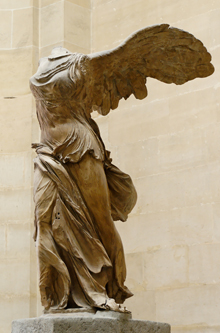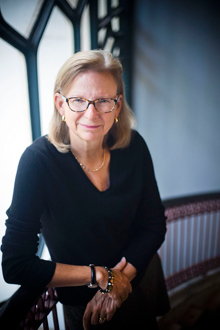
Emory scholarship is at the forefront of a conservation project on the Winged Victory of Samothrace in the Louvre in Paris — one of the most famous statues in the world in one of the world's most well-known museums.
The 2,200-year-old, 18-foot-high statue, also known as "the Nike" (the Greek word for Victory), was taken off display earlier this month for approximately nine months to be cleaned.
Emory art history professor Bonna Wescoat is director of excavations in the Sanctuary of the Great Gods on the Greek island of Samothrace, the original home of the Winged Victory. Wescoat, along with scholars and students from Emory and New York University's Institute of Fine Arts (IFA), along with Greek and French colleagues, is bringing the latest research on the statue from the island to aid in the Louvre's restoration.
The base on which the statue stands in the Louvre is in the form of the prow of a warship. The French discoverer of the Winged Victory, Charles Champoiseaux, left the center block of that base behind on Samothrace when he brought the statue to Paris in the 19th century.
"But that was the crucial block on which the figure stood," Wescoat explains. Most of the base is in Paris, except for the central block and numerous smaller fragments, "including four more that we found this summer" during excavations on Samothrace.
The Louvre team will also be looking very carefully at the relationship of the statue to its base, and this is where Emory plays a role, she notes.

Emory art history professor Bonna Wescoat. Emory Photo/Video.
The problem for the Louvre is without that block, the statue cannot rest directly on the base. It is suspended over the base on an intermediate block that's rather awkward-looking, she says. "So one of big the efforts will be to situate her more precisely on the base."
A high-resolution scan of the block will give Louvre officials the option of deciding to reproduce a center block or use the image to understand the position of the statue. "I don't know which they're going to choose to do," Wescoat says, but intends to find out when in Paris this week.
In addition to the center block, the Emory/IFA/Louvre team located a number of fragments on Samothrace that fit into the pieces that the Louvre has. "We also have evidence of blocks they don't have, particularly near the ram. We scanned all these digitally, and we will work with these scans to see how the fragments in the two countries join together," she says.
"It's a challenge when you have a fragment on Samothrace and the larger block in Paris. So technology has helped to bring these two together," she notes.
Wescoat says the Emory team will also be contributing the knowledge they discover about the history and design of the precinct in which the Winged Victory originally stood.
"We spent a good deal of time this summer with our French colleagues and Emory students looking at every single fragment and understanding exactly where each fits in the reconstruction of the ship," Wescoat says. "We're very satisfied with our results. We think we've figured out most of the fragments and we have some important new information."
Wescoat talked about the relative speed of the Louvre’s project, but the Victory is "a very famous monument and having it off-view every day is a loss. They're very conscious [about getting] her back on view in a more spiffed up and reoriented position."
Wescoat, who is in Paris this week to work with an international commission that is advising the cleaning and restoration process, will return to Paris in January, when the group of scholars will assess the progress. Another visit is tentatively planned for June, around the time things are wrapping up and "hopefully, she's back on view."
"People care about the Nike and this is a chance for us to share with people our work," Wescoat says.
Wescoat praised the team working this summer on Samothrace. "You just can't believe how much was done by Emory students this summer. They were amazing," she says of students Clare Mullins, Hannah Smagh, Becky Levitan, Zach Domach, Alison Hight and An Jiang. Also instrumental were Bill Size, Emory professor of environmental studies and Michael Page, Emory geographer. Students from IFA, co-sponsor of the mission, were equally engaged in the success of the project.
"Archeology is a team effort and they were a fabulous team."
